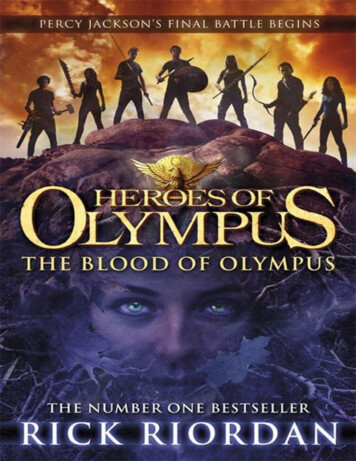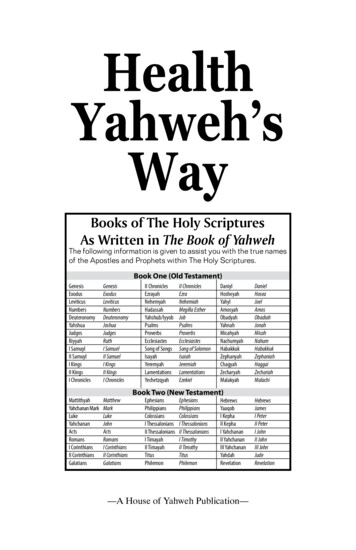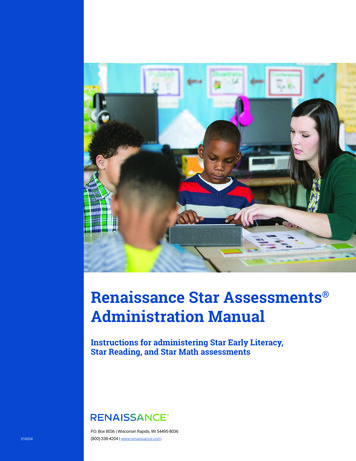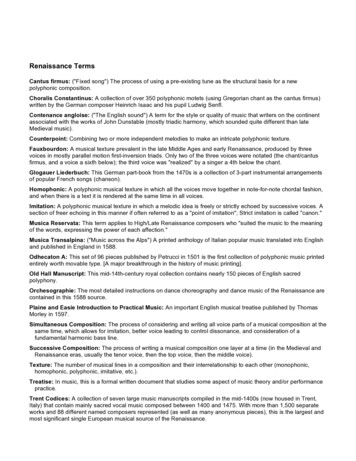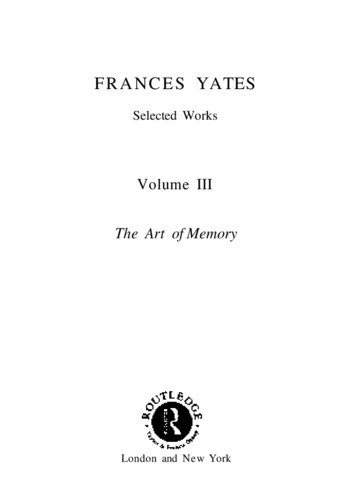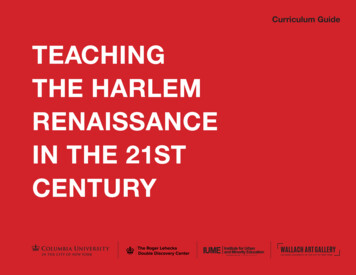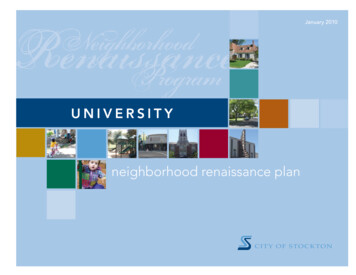
Transcription
Vol. 1, No. 1, August 2012, pp. 11-25The Chronicles of the Renaissance GroupMichael J. Giovannetti, Executive DirectorThe Renaissance Group ( 2008-Present)California State University, FresnoAbstractThe Renaissance was a cultural movement initiated in Florence, Italy, during thelate Middle Ages and later spread to the rest of Europe, focusing on theimprovement of various disciplines through a revival of ideas from antiquity. Theinfluence of the Renaissance movement affected art, literature, philosophy,politics, science, religion, and other aspects of intellectual inquiry. What does theRenaissance movement of fourteenth century Italy have to do with TheRenaissance Group (TRG) of 21st America? The times and places may be verydifferent, but as we review TRG’s contributions to teacher education from the1980s to the present (a time during which The Renaissance Group laid a strongfoundation to shape this national consortium of colleges, universities andprofessional organizations) we may discover more similarities between the twothan imagined.
12M. GiovannettiThe Chronicles of the Renaissance GroupBackgroundThe Renaissance Group: Who are its members? Visionaries, dreamers, educationalleaders?The Renaissance (French for “rebirth”; Italian, Rinascimento, from re - “again” andnascere -“to be born”) was a cultural movement initiated in Florence, Italy, in the late MiddleAges and later spread to the rest of Europe, encompassing periods from the fourteenth to theseventeenth century. This time was focused on the improvement of various disciplines through arevival of ideas from antiquity, by employing creative approaches to thinking and doing. Theinfluence of the Renaissance movement affected art, literature, philosophy, politics, science,religion, and other aspects of intellectual inquiry.What does the Renaissance movement of fourteenth century Italy have to do with TheRenaissance Group (TRG) of 21st America? The times and places may be very different, but aswe review TRG’s contributions to teacher education from the 1980s to the present (a time duringwhich The Renaissance Group laid a strong foundation to shape this national consortium ofcolleges, universities and professional organizations) we may discover more similarities betweenthe two than imagined.I have been a member of The Renaissance Group since July 1, 2008, as the organization’sExecutive Director. Because my tenure with this incredible group of educational leaders hasbeen relatively short, I must resort to presenting TRG’s life through the eyes and experiences ofa fairly new observer, as I interpret information availed to me by colleagues, through reviews oforganizational files, as well as from my direct observations and experiences during the past fouryears. However, in order to relate a fairly complete story, I must first take us back in time,approximately 25 to 30 years, and briefly revisit the state of public education during those initialyears up to the present.By examining the educational challenges and reform movements of the 1980s, 1990s, and2000s, one can easily extract from local, state, and national news media unfavorable, highlycritical messages about America’s P-20 public school systems. For a number of years, activecriticism of our schools has been on the front burner of public debate, allowing schools to beseen as one cause for what is considered to be “wrong” with modern-day America. During thosechallenging years, A Nation at Risk: The Imperative For Educational Reform was published in1983, as part of President Ronald Reagan’s National Commission on Excellence in Education’sefforts to improve the academic performance levels of American high school students.Approximately two decades later, in 2001, the No Child Left Behind legislation targeted theimprovement of student achievement levels by raising academic standards for all P-12 students.Race to the Top in 2009 challenged all educators to implement and enforce rigorous standardsand assessments for all students. Recently, the Common Core State Standards have taken centerstage for the educational rebirth of America’s P-20 institutions, serving as a forceful reminderthat achievement standards need to be seriously addressed in all corners of the country if the U.S. hopes to regain a prominent place in world leadership.The public schools of our nation have always exhibited one unique characteristic: allstudents who enter their schoolhouse doors will be accepted and served, regardless of needs andabilities. Perhaps it is this concept of absolute inclusion that that has lead the citizenry of
The Chronicles of the Renaissance Group 13America to conclude that the ailments expressed within our neighborhoods must be caused by orsomehow associated with our public schools, their teachers, their staff, or their administrators.Who else could be held responsible? After all, these individuals do influence our youth each andevery day they attend classes. Although I present this discourse with a strong dose of cynicism,it is precisely this form of expression that has motivated our elected leaders to fuel the numerouseducational reform movements of the past and the present.The Early YearsThe Renaissance Group consortium was conceived during the spring of 1989, a time ofincreased expectations for schools and for teacher education programs in colleges anduniversities. The world encountered issues not much different from those we experience today,and not all that different from 14th century Europe, if we consider and reflect upon the increasedexpectations for the leaders, educators, artists and scholars of that era. Criticism of teacherpreparation programs has been the focal point of national debate since I can remember. Theuniversity presidents, provosts and deans who first gathered at the University of Northern Iowain the spring of 1989 (see Figure 1), and those who joined them in a series of meetings thatFigure 1. The Renaissance Group leadership planning session.followed, were motivated to embark on a rebirth movement in order to try to bring new life toeducator preparation programs. The educational leaders of the late 1980s, representing the top
14M. Giovannettileadership of some the finest higher education institutions in the country, were visionary in theirbelief and firm in their conviction that the education of teachers must become an all-campusresponsibility. They were clearly the Leonardos and the Michelangelos of the 20th century (seeFigure 2)!Figure 2. Renaissance-style celebration and meeting.The University of Northern Iowa was the first home of the executive offices of theRenaissance Group, with Dr. William Callahan as Executive Director. Emporia State Universitywas the second home. These were most critical times for the young, yet experienced andenergetic, leadership team of TRG; times during which a solid organizational foundation wasbeing shaped and new members identified and invited to strengthen the educational settingswhere teachers were being prepared. According to Dr. Tes Mehring, Provost and Vice Presidentfor Academic Affairs at Emporia State University, one of the early leaders of TRG, this was alsoa period of connectivity with major education organizations, such as the American Associationfor State Colleges and Universities, the American Association for Colleges of TeacherEducation, the National Board for Professional Teaching Standards, and the National SchoolBoard Association, to mention only some of the best known. Additionally, it was during thistime that The Renaissance Group and the U.S. Department of Education initiated meaningfuldiscussions in support of teacher preparation programs. Nationally recognized speakers oftendelivered the keynote addresses at conferences held in the Washington, DC area during their fallannual meetings. Throughout these very important foundational years, the initial joint meetingswith TRG and the Teacher Education Council of State Colleges and Universities (TECSCU) also
The Chronicles of the Renaissance Group 15took place. The Renaissance Group has always been committed to quality programs for thepreparation of teachers, counselors, and administrative leaders for our nation’s schools. Theinitial meeting held in Iowa by a handful of university presidents and education deans wasfollowed by a quick succession of meetings at the University of Northern Colorado, WesternKentucky University, California State University, San Bernardino, and at Emporia StateUniversity. As TRG added more member institutions, provosts and arts and science deans wereincluded as key members of TRG (see Figure 3). This core group of university presidents,Figure 3. Meeting at California State University, Fresno.provosts, arts and science deans, and education deans from member institutions continues to berepresented on The Renaissance Group Board of Governors today(http://www.csufresno.edu/renaissancegroup/). The founders and leaders of TRG have spenttheir time and resources for the past 23 years focused on the organization’s belief that with theright kind of campus infrastructure, and with continuing support of key campus administrators,teacher education will remain a university priority at TRG member institutions (see Figure 4).
16M. GiovannettiFigure 4. TRG founders/leaders at the annual fall conference, Arlington, VA.Oral History Research Initiative and The Twentieth Anniversary Celebration/ConferenceDuring my review of archived documents, I uncovered some additional insights about theearly development of TRG. These findings were confirmed in 2009, through extensiveconversations with founding leaders of the organization including Dr. Thomas Switzer (seeFigure 5), Dean Emeritus of the Judith Herb College of Education at the University of Toledo,member of TRG’s Board of Governors for a number of years, and one of the principal foundersand developers of The Renaissance Group. Dr. Switzer was instrumental in organizing the oralhistory research initiative that prominently kicked off the 20th anniversary celebration andconference held in October 2009 in Arlington, VA. This event was designed to be a time ofreflection, celebration and rebirth, and it truly was! His ingenious idea generated a respectablecollection of anecdotes and insights about the beginnings and initiatives of The RenaissanceGroup, as presented by a number of the organizations’ founders and leaders. The oral historyresearch initiative, the 20th anniversary conference agenda, and pictures of participants may beexperienced by visiting TRG’s website at http://www.csufresno.edu/renaissancegroup/.
The Chronicles of the Renaissance Group 17Figure 5. Dr. Switzer – recipient of the first TRG Annual Leadership Award.I was most fortunate to be able to conduct many of those interviews. One story ofparticular interest and importance relates to the origin of the organization’s name, TheRenaissance Group, which others and I initially believed to be named after the EuropeanRenaissance movement. After all, TRG’s primary principle that the preparation of educators bean all-campus responsibility was a type of educational rebirth. However, as exciting andromantic as that notion might be, the truth of the matter is that during one of their early meetings,in July of 1989, TRG’s leaders were enjoying the peace and beauty of Estes Park, Colorado, thehost site for one of their early planning sessions. This very prominent event happened to takeplace in the Renaissance Room of a local lodge, hence the name The Renaissance Group (seeFigure 6).
18M. GiovannettiFigure 6. One of the early planning meetings – Estes Park, CO, the Renaissance Room.Twenty-three years have naturally seen many changes in the membership and leadershipof TRG. The original leaders have reached or are approaching the end of their professionalcareers. Sadly, some of them have already passed away. Thanks to the oral history researchinitiative of 2009, accounts of some of the work and reflections of these innovators exist todayand some of the knowledge gained from their individual and collective efforts to develop qualityprograms for the preparation of teachers is not lost to future generations. The oral historyresearch initiative attempted to capture the rich knowledge and wisdom of those educationalleaders and mentors whose exemplary work is reflected today in TRG institutions throughout thecountry. The oral histories were completed with the assistance of modern informationtechnology from various universities, particularly from Western Kentucky University, capturingboth voice and video of some of The Renaissance Group founders and leaders. Approximately30 past and present leaders of TRG were initially identified as potential participants. TheUniversity of Toledo, under the leadership of Dr. Thomas Switzer, Dean of the Judith HerbCollege of Education, was the home base for the oral history research initiative. WesternKentucky University, under the leadership of Dr. Barbara Burch, Provost and Vice President forAcademic Affairs, and Mr. David Brinkley, Senior Producer, Director and Writer of EducationalTelevision Services, continued the work initiated by Dr. Switzer and supported it to itscompletion. The video presenting the first 20 years of TRG’s life may be viewed on theorganization’s website at www.csufresno.edu/renaissancegroup.
The Chronicles of the Renaissance Group 19The Middle YearsMembers of the Board of Governors and all member institutions of The RenaissanceGroup continuously renew their commitment to improving teacher preparation programs byreflecting on past practices, celebrating accomplishments, embracing present and futureeducational challenges, and by sharing strategies and promising practices designed to improvelocal, regional, and national learning environments. The membership has grown over the past 20years, attracting 35-40 member institutions during its development. For several years, theexecutive office of The Renaissance Group was located at Emporia State University, Emporia,Kansas. There, thanks to the outstanding leadership of Dr. Kay Schallenkamp, President, Dr. TesMehring, Provost and Vice President for Academic Affairs, and Dr. Leo Pauls, ExecutiveDirector, TRG grew and significantly strengthened its original foundation (see Figure 7).Figure 7. Emporia State University, Spring Conference.Today, more than ever, all TRG members proudly support the tradition of strongcommitment for the preparation of educators as a campus-wide effort and are pleased toannounce that a significant number of teachers successfully prepare for the profession at TRGinstitutions. In keeping with past practice, tradition, and the belief that supporting educator
20M. Giovannettipreparation programs and initiatives is the best investment our nation can make, The RenaissanceGroup continues to provide each year, as it has done annually since its inception, uniqueopportunities for educators to celebrate their successes and recommit their individual andcollective research, talents, and resources for the preparation of outstanding educators forAmerica’s schools. Those who believe that excellent teaching translates into more successfulstudents have supported and continue to support the efforts of this unique organization. Bydoing so, the educational leadership of our country contributes to the much-needed rebirth of ournation’s schools, positively influencing national policy and practices relative to the design andimplementation of outstanding teacher preparation programs. The organization’s vision,principles and strategic plan, reflected on the following tables, have always guided the work ofThe Renaissance Group.The Renaissance Group VisionLeadership in the exemplary preparation of educators through full campus commitment, incollaboration with P-12 School Districts, for the transformation of education to meet societalneeds.The Renaissance Group Principles (September 2009)The Renaissance Group: Universities working to improve the quality of educator preparation. The education of teachers is an all-campus responsibility undertaken in collaborationwith P-12 school personnel. The university values and models teaching excellence. Teacher preparation is integrated across the curricula of general education, in-depthsubject matter content, and professional studies in both general content and specificteaching methodologies. The education of teachers incorporates extensive and sequenced field and clinicalexperiences in various settings with effective supervision. The university meets and exceeds national and state standards for the preparation ofschool personnel. The university assesses learner outcomes in order to monitor its program effectivenessand assure teacher quality. Pre-service teachers and faculty members reflect our pluralistic society and arecommitted to the education of all students in diverse schools. The continuing professional development of teachers is the shared responsibility of theindividual, the university faculty, and other professional educators. The university provides learning experiences and mentoring that develop teachers whoare creative and innovative leaders. The university integrates technology throughout its teacher preparation program.
The Chronicles of the Renaissance Group 21Strategic Plan Update (December 2010)The Renaissance Group, building from two decades of leadership in teacher education, seeks toprovide relevant and meaningful service to our members and partners. As we embrace thechanges of the 21st century, TRG will endeavor to achieve its mission and vision through astrategic focus on three goals.I. TRG will provide enhanced benefits for member institutions.Measures of Performance Develop a timely and relevant “signature project”. Facilitate a process whereby member institutions collaborate in the collection andsharing of relevant legislation, data, grant ideas, best practices, etc. Represent the membership in a strengthened alliance with Department ofEducation. Provide pre-NCATE reviews for member institutions. Facilitate communication between member institutions and P-12 programs toensure congruence with current educational demands. Re-evaluate the conference structure and content to provide greater incentive forinvolvement by university presidents, legislators, school superintendents, andother stakeholders.II. TRG will develop a common set of standards that define a TRG teacher education programgraduate and guide TRG institutions in decision-making.Measures of Performance Identify quantity, quality, and nature of the expectations for graduation such asacademic field preparation, clinical/classroom based experiences,practicum/student teaching experiences, internship, and graduation requirementsacross institutions.III. TRG will create a broader marketing plan to increase visibility across multiple educationalcommunities.Measures of Performance Clarify and strengthen the mission and vision statement to reflect the evolvingpurpose of the organization. Create appropriate media that will be versatile and highly visible such aspublications, DVDs, social networking, brochures, etc. Partner with affiliate members to have a common voice in educational policydevelopment.
22M. GiovannettiSignature ProjectsOver the years and as presented in the 2010 Strategic Plan update, signature projectsinitiated by TRG members have provided guidance, direction and courageous leadership at local,state and national levels to inspire change, to guide policy and to improve all aspects of educatorpreparation programs on college and university campuses in America.1999 - Teacher Work SamplesPerhaps one of the best examples of innovation and accountability relative to thepreparation of educators is the development of the teacher work samples, authored in 1999 byDr. Roger Pankratz, Professor and Assistant to the Dean of Education and Behavioral Sciences,Western Kentucky University, in collaboration with eleven TRG member institutions.The Renaissance Partnership for Improving Teacher Quality program (1999-2005) is theresult of a Title II federally funded project with Offices at Western Kentucky University, andwith its Director, Dr. Roger Pankratz. The eleven Renaissance partnership project sites includedCalifornia State University Fresno; Eastern Michigan University; Emporia State University;Idaho State University; Kentucky State University; Longwood University; Middle TennesseeState University; Millersville University; Southeast Missouri State University; University ofNorthern Iowa, and Western Kentucky University.Thanks to the Renaissance teacher work samples, today many colleges and universitiesacross the country have developed effective, reliable measures to evaluate the preparation levelsof the teachers they graduate. Additionally, results from the teacher work samples assessmentsare utilized to inform faculty and administrators relative to needs and improvements for theirteacher preparation programs.2011 - Co-Teaching ModelA second, equally important partnership was formed in 2011 with Saint Cloud StateUniversity, member of TRG since 2000, when they offered their co-teaching model for teachercandidate preparation as a TRG signature project. Dr. Nancy Bacharach and Dr. Teresa Heck,faculty at St. Cloud State, developed the co-teaching model with funding from a federal grant.There is a growing demand for teacher preparation institutions to develop highly effectiveteachers. The goal of this project is to reform teacher preparation through the implementation ofa research-based model of co-teaching in student teaching at teacher preparation institutionsacross the country. Because very little data exist connecting success in a student teachingexperience with student learning outcomes, more studies would be extremely beneficial to P-20education. Co-teaching is not a new phenomenon; however, its application in the studentteaching experience is a new area of study. This student teacher preparation model is designed toassist both the cooperating teacher and teacher candidate in collaboratively planning, organizing,delivering, assessing, and sharing the physical space of the classroom. Co-teaching allows theclassroom teacher to partner with the teacher candidate rather than give away responsibility.Four years of research conducted on a co-teaching model of student teaching has demonstrated astatistically significant increase in academic performance for elementary learners in co-taughtclassrooms. The quantitative and qualitative data support co-teaching as an exemplary practicethat has the potential to reform teacher preparation and student teaching, as we know it today.The Renaissance Group applied for a federally funded multi-million dollar grant in 2011.The grant proposed to expand the co-teaching model initially developed at St. Cloud State
The Chronicles of the Renaissance Group 23University and included specific plans to provide the training and support necessary for otherteacher preparation institutions across the nation to successfully implement this model. The 13institutions identified to participate in the proposal collectively produce over 4100 teachers eachyear and work with over 800 school partners. One hundred percent of these institutions workwith high needs schools and all of them place students in classrooms where Adequate YearlyProgress (AYP) has not been met. In fact, almost 85% of the placements made are in identifiedhigh needs schools. A comprehensive plan for assessing the impact of this model was alsoincluded in the application, and the results of this work would be disseminated to state, regional,and national audiences. This train-the-trainer model is not only sustainable, but can also producea cadre of individuals capable of national implementation. In spite of this commendable effort,the grant was not funded. However, TRG will not stop trying to contribute to the improvementof teaching and learning, and will undoubtedly explore future funding opportunities for theexpansion of this and other promising practices.An additional significant effort of The Renaissance Group is the development of thefollowing educational journal. Started in 2011, Educational Renaissance is a publicationsponsored by The Renaissance Group. Educational Renaissance is to be published twice a yearto facilitate communication among professional educators and those whose research focuses onteacher preparation as well as those committed to the improvement and reform of educationlocally, regionally and nationally. Manuscripts submitted to Educational Renaissance shouldconform to the language, style, and a modified format of the Publication Manual of theAmerican Psychological Association (6th ed., 2009). All manuscripts should be submittedelectronically to the editor through the Open Access journal system at:http://educationalrenaissance.org/. Once received by the editor, manuscripts will beanonymously peer-reviewed by at least two reviewers. Potential authors are encouraged tocontact the editor to discuss ideas for contributions, or determine if their manuscript is suitablefor publication in Educational Renaissance. Dr. Paul Beare, Dr. Jim Marshall and Dr. PatrickNewell, at California State University, Fresno, the lead TRG member institution for EducationalRenaissance, as well as a number of reviewers from TRG member institutions, lead this project.TRG TodayThe Renaissance Group moved its Executive Office in 2005 from Emporia State toCalifornia State University, Fresno, (Fresno State) in the heart of California. In its new home,Dr. John Welty, President; Dr. Paul Beare, Dean of the Kremen School of Education and HumanDevelopment; Mr. Rich Firpo, Executive Director (2005-2008); and, in keeping with TRG’stradition of excellence, the entire university faculty and staff welcomed and embraced thisnational educational consortium dedicated to the enhancement of teaching and learning. Theoutstanding support and commitment by Fresno State, not unlike the contributions made by theUniversity of Northern Iowa, Emporia State University, and all of TRG’s leadership, has made itpossible for The Renaissance Group to continue its original journey and to stay the course for theimprovement of educator preparation programs (see Figure 8).
24M. GiovannettiFigure 8. 20th Anniversary Conference, Arlington, VA.The past seven years have experienced a small decline in membership, nothing seriousenough to dampen the spirit of The Renaissance Group. Thanks to the outstanding leadershipand dedication of Dr. John Counts, President Emeritus of Western New Mexico University andPresident of TRG’s Board of Governors for the past seven years, and to all past and presentmembers of TRG’s Board, annual conferences designed to showcase the very best educatorpreparation programs have been offered in the Washington, DC area. Additional meetings havealso been held at member institutions to address the present needs and interests of members andguests. Finally, with strong support from Mr. Otto Benavides, Associate Professor and Directorof the Instructional Technology and Resource Center at the Kremen School of Education andHuman Development at California State University, Fresno, the utilization of videoteleconferencing has offered a significant level of assistance to help conduct all other TRGbusiness and planning sessions.In 2011, The Renaissance Group also renewed its partnership, initially formed when TRGwas housed at Emporia State University, with a national organization of similar purpose,dedication and interests, the Teacher Education Council of State Colleges and Universities(TECSCU). Together, these educator preparation program architects and developers,representing higher education institutions preparing approximately 78% of America’s teachers,have designed and delivered one successful Joint Conference in the Fall of 2011 and arecurrently planning a second meeting to be offered during the Fall of 2012. Dr. MaryGendernalik-Cooper, Education Dean at the University of Mary Washington, and Dr. MichaelGiovannetti, Executive Director of The Renaissance Group serve as co-chairs of this jointconference.The Fall 2012 event, with the theme of The Proof of Effective Partnerships: EducatorsMeeting the Challenges and Opportunities of the 21st Century is scheduled for September 29 to
The Chronicles of the Renaissance Group 25October 2 in Arlington, Virginia. The 2012 joint meeting of TECSCU and TRG will examinethe evidence of resilient partnerships in teacher and education leadership preparation, byexamining and discussing richly diverse models of collaboration.ConclusionI realize the story I have shared only begins to scratch the surface of the treasure chest ofsignificant contributions made by a number of outstanding educational leaders to one uniquenational organization and to P-20 education in America. Clearly all who deserve to be includedin these chronicles were not, and for all omissions, the author extends his most sincere apology.Hopefully these accounts will serve as a reminder that when The Renaissance Group was formed23 years ago by a group of educational leaders dedicated to the improvement of teacherpreparation programs, their mission was clear: this national consortium of colleges, universitiesand the National Board of Professional Teaching Standards has always known that in order toprepare the finest educators to effectively serve all of America’s students, they must do so as anall-campus responsibility, in conjunction with its P-12 school district partners. I am confidentthe invaluable contributions made by TRG will continue to benefit P-20 education into thefuture, thanks to the leadership, dedication, and commitment of all past and present members.Criticism about our profession will more than likely continue, but I firmly believe that whenpersons of good will work together and persevere, amazing things will continue to happen.The preparation of The Chro
followed by a quick succession of meetings at the University of Northern Colorado, Western Kentucky University, California State University, San Bernardino, and at Emporia State University. As TRG added more member institutions, provosts and arts and science deans were . member of TRG's Board of Governors for a number of years, and one of .




